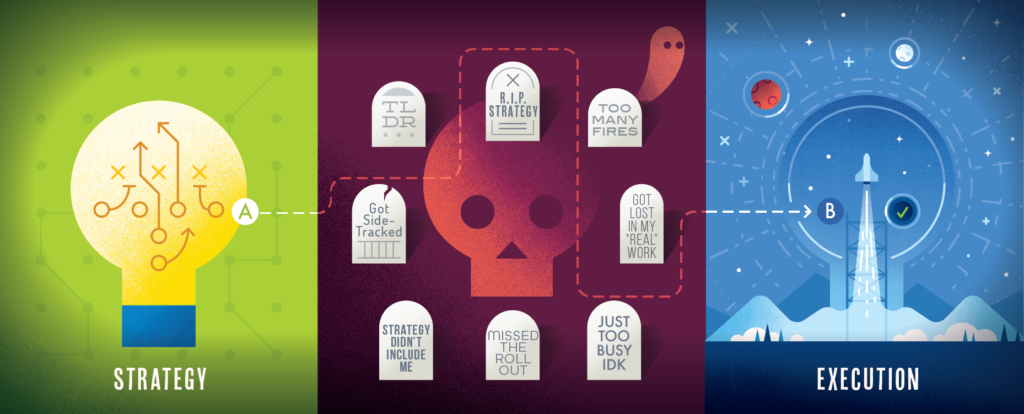Execution is where good strategies go to die
By Drew Mattison (alum)
Why? Because there’s usually a gap between strategy (the thinking) and execution (the doing).
Leaders spend a ton of time and money designing a new strategy only to watch as teams pull in different directions, new initiatives take priority, and people become overwhelmed with fighting fires. Predictably, the new strategy never truly delivers on the promise, and, in many cases, simply dies.
That’s because the world moves unrelentingly fast—and so does your competition. So it’s critical for today’s leaders to close the strategy/execution gap by cutting through the noise, accelerating the right work, and aligning teams so they know what to do and can make informed decisions.
Bridging that gap requires an Activation Plan that turns a strategy into an executable plan people can understand. Activation Plans help people align on what the strategy actually is, agree on priorities, and clarify decision-making parameters. It helps leaders and their teams know what to do.
First, align on what the strategy actually is
It’s amazing how often people walk out of the same meeting with completely different takes on what was decided. Business must move fast, and often people don’t even realize that each of them has heard the tenets of a new strategy very differently.
Getting people and functional teams on the same page is crucial to getting them to go in the same direction. Alignment requires more than a slide deck—it requires an Activation Plan. You’ve got to get team leaders together in the same room so they can define what each piece of the strategy means for each team.
We think that this alignment is most successful if it occurs as soon as possible after the strategy is introduced. And it’s most effective if cross functional teams work together on this so everyone knows what other teams are doing.
Now agree on the priorities
Not everything can be a priority, but at many companies that’s the way it feels. Every new initiative is urgent, people get pulled in different directions, and ultimately the business loses sight of the strategy.
Priorities are choices. When you develop a strategy you are making very specific, critical, considered choices. We make leaders ruthlessly prioritize because that helps their teams understand what to focus on.
And knowing what to focus on helps teams more accurately plan and predict how long work will take so organizations can better understand when a project will be delivered. When every team is pursuing the same priorities outlined in an Activation Plan, it’s easier for different functions to begin collaborating.
Once those strategic priorities are set, any new initiative must be evaluated against those same priorities. And all metrics should be lined up to those strategic priorities—because what gets measured is what gets done.
Finally, clarify decision-making parameters
For teams to move fast, people need just enough structure so they can make decisions and keep moving. This means leaders must quit micromanaging and simply clarify what’s fixed and where people have room to run. We know it can be hard for leaders to hold back from getting involved in every decision as a strategy is executed, but there is a way.
An Activation Plan helps set clear guardrails and expectations, outlining, say, how you expect your sales team to keep your CRM system up-to-date, to know all the latest products and pricing, and that they have the room to use their experience to solve problems for customers. For example, it can clarify how salespeople have the latitude to solve any issue up to a certain dollar amount, or how a development team has the leeway to make decisions up to a certain threshold.
What people really need is a destination, some guardrails, and the basic rules of the road. This helps them execute with speed and confidence, bringing your new strategy to life and delivering on the promise—rather than allowing it to wither and die.
This post was co-written with Cynthia Owens. Illustration by Chris Roettger / Tremendousness.
